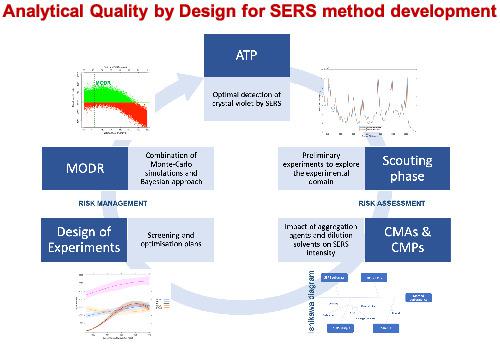当前位置:
X-MOL 学术
›
J. Raman Spectrosc.
›
论文详情
Our official English website, www.x-mol.net, welcomes your feedback! (Note: you will need to create a separate account there.)
Application of the analytical quality by design principles to the development of a qualitative surface-enhanced Raman scattering method: A proof of concept
Journal of Raman Spectroscopy ( IF 2.5 ) Pub Date : 2021-09-06 , DOI: 10.1002/jrs.6249 Riccardo Deidda 1 , Hermane T. Avohou 1 , Elodie Dumont 1 , Cédric Hubert 1 , Philippe Hubert 1 , Charlotte De Bleye 1 , Éric Ziemons 1
Journal of Raman Spectroscopy ( IF 2.5 ) Pub Date : 2021-09-06 , DOI: 10.1002/jrs.6249 Riccardo Deidda 1 , Hermane T. Avohou 1 , Elodie Dumont 1 , Cédric Hubert 1 , Philippe Hubert 1 , Charlotte De Bleye 1 , Éric Ziemons 1
Affiliation

|
Analytical quality by design (AQbD) is a systematic approach that allows developing analytical methods in a more science-based way, due to the higher quality of information collected during the development process. However, its application remains limited to the development of separation methods. (i.e., liquid chromatography and capillary electrophoresis). Its application to spectroscopic techniques remains underexplored, despite the potential benefits. The aim of this work was to demonstrate the application of the AQbD principles to surface-enhanced Raman scattering (SERS) method development, detailing each step characterizing this approach. First, crystal violet (CV) was chosen as a model compound and the analytical target profile was defined. Risk assessment was performed to individuate the critical method parameters. The intensity of the CV band at 1175 cm−1 was selected as critical method attribute to be modeled and maximized. A screening study was conducted to study 11 aggregation agents (AAs) at different concentration levels (range 0.010–1 M) and in two solvent media (aqueous and methanolic). The two AAs exhibiting the strongest signal, one for each medium, were retained. Once these parameters were fixed, an I-optimal design was applied to optimize the entire analysis process. Here, the volumes of nanoparticle suspension and AA solution added to the SERS samples were simultaneously varied. Two method operable design regions, one for each medium, were computed using a Bayesian design space approach. The latter enabled evaluating the failure risk associated to each experimental condition explored and choosing those that best fit the analytical purpose in the experimental domain.
中文翻译:

通过设计原理分析质量在开发定性表面增强拉曼散射方法中的应用:概念验证
设计分析质量 (AQbD) 是一种系统方法,由于在开发过程中收集的信息质量更高,因此可以以更科学的方式开发分析方法。然而,它的应用仍然局限于分离方法的发展。(即液相色谱和毛细管电泳)。尽管有潜在的好处,但它在光谱技术中的应用仍未得到充分探索。这项工作的目的是展示 AQbD 原理在表面增强拉曼散射 (SERS) 方法开发中的应用,详细说明了表征该方法的每个步骤。首先,选择结晶紫 (CV) 作为模型化合物并定义分析目标谱。进行风险评估以区分关键方法参数。-1被选为要建模和最大化的关键方法属性。进行了一项筛选研究,以研究不同浓度水平(范围 0.010-1 M)和两种溶剂介质(水和甲醇)中的 11 种聚集剂 (AA)。保留了表现出最强信号的两个 AA,每种介质一个。一旦这些参数被固定,一个 I 最优设计被应用来优化整个分析过程。在这里,添加到 SERS 样品中的纳米颗粒悬浮液和 AA 溶液的体积是同时变化的。使用贝叶斯设计空间方法计算了两种方法可操作的设计区域,每种介质一个。后者能够评估与探索的每个实验条件相关的故障风险,并选择最适合实验领域分析目的的那些。
更新日期:2021-09-06
中文翻译:

通过设计原理分析质量在开发定性表面增强拉曼散射方法中的应用:概念验证
设计分析质量 (AQbD) 是一种系统方法,由于在开发过程中收集的信息质量更高,因此可以以更科学的方式开发分析方法。然而,它的应用仍然局限于分离方法的发展。(即液相色谱和毛细管电泳)。尽管有潜在的好处,但它在光谱技术中的应用仍未得到充分探索。这项工作的目的是展示 AQbD 原理在表面增强拉曼散射 (SERS) 方法开发中的应用,详细说明了表征该方法的每个步骤。首先,选择结晶紫 (CV) 作为模型化合物并定义分析目标谱。进行风险评估以区分关键方法参数。-1被选为要建模和最大化的关键方法属性。进行了一项筛选研究,以研究不同浓度水平(范围 0.010-1 M)和两种溶剂介质(水和甲醇)中的 11 种聚集剂 (AA)。保留了表现出最强信号的两个 AA,每种介质一个。一旦这些参数被固定,一个 I 最优设计被应用来优化整个分析过程。在这里,添加到 SERS 样品中的纳米颗粒悬浮液和 AA 溶液的体积是同时变化的。使用贝叶斯设计空间方法计算了两种方法可操作的设计区域,每种介质一个。后者能够评估与探索的每个实验条件相关的故障风险,并选择最适合实验领域分析目的的那些。



























 京公网安备 11010802027423号
京公网安备 11010802027423号